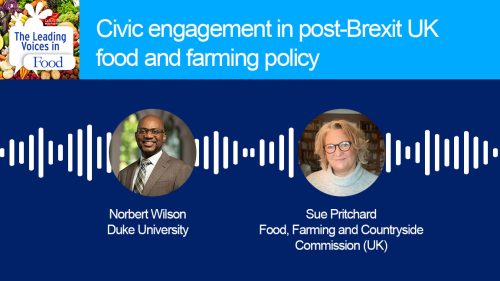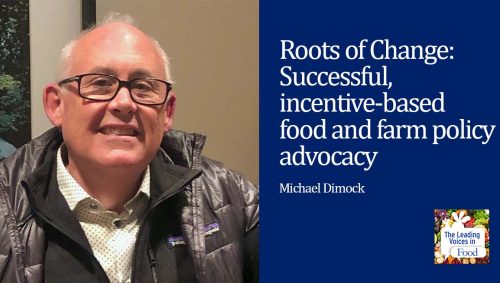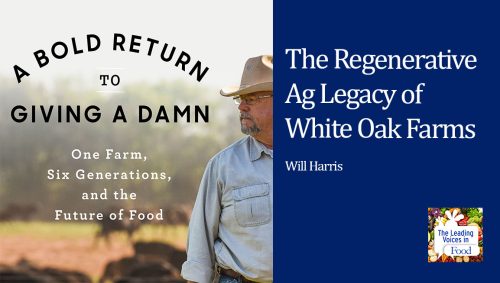The Leading Voices in Food
E167: Muller Shepherding Regenerative and Restorative Agricultural Practices
Today’s podcast is part of our Regenerative Agriculture series. I’m speaking with Mark Muller, Executive Director of the Regenerative Agriculture Foundation (RAF). The RAF seeks to foster the economic policy and knowledge conditions that support land stewardship, climate solutions, racial equity, adjust economy, and thriving rural communities.
Subscribe: Apple Podcasts | TuneIN | YouTube Music | SoundCloud | PocketCasts | Radio Public
Tags: Agriculture & Tech | Climate Change, Environment & Food | Regenerative Agriculture |

Mark Muller is the new Executive Director of the Regenerative Agriculture Foundation. He has a strong track record in the non-profit and philanthropic worlds, and commitment to scaling regenerative agriculture. Mark was previously at the McKnight Foundation where he served for over six years, first as program officer and subsequently as program director of the Mississippi River program. In this capacity, Mark helped scale up regenerative agriculture practices in the Mississippi River basin, pressed for stronger action in support of environmental justice, and supported federal and state policy efforts for healthy soils and clean water. He has spent most of his career working to help transform our agricultural and food systems, starting with part-time jobs while in college supporting farmworkers, providing Integrated Pest Management services to farmers, and spending a season on a diversified organic vegetable farm. Muller also taught science for two years at a high school in New York City, volunteered for a year in Honduras and Guatemala, and has served on several nonprofit boards and a local natural foods co-op. He served in several roles during his fourteen years at the Institute for Agriculture and Trade Policy, including directing the Food & Community Fellows, a fellowship program explicitly focused on building racial equity in the food system. Mark has a BA in physics and a MA in environmental engineering. He and his spouse have three children and have lived in the Midtown Phillips neighborhood of Minneapolis for the past 20 years. They are part owners of a family farm in Iowa.
Interview Summary
So Mark, your paths and mine have intersected over the years in very pleasant ways, and I’ve admired the work you do. And when you went to work with the Regenerative Agriculture Foundation, I thought, “Boy, this is a perfect match.” And I’m so happy that you and the Foundation are part of the same picture now. So I’d like to ask, first if you could tell our listeners about the Foundation, and what does the organization hope to accomplish? Because the Foundation itself says that regenerative Ag is not a new idea, that it’s difficult to define, it’s grounded in community, and it’s a journey. So I’d love to hear you explain how all this comes together into a coherent idea.
So the Regenerative Agriculture Foundation, we are an intermediary funder, which means that we received grants from RV Family Foundations. Our founding entity was the 11th Hour Project of the Schmidt Family Foundation. And the idea is that we can utilize those funds more efficiently by having a solid knowledge-base of what’s going on – on the ground in regenerative Agriculture. And so that we can re-grant those dollars to be more effectively used around the country. I was brought on about 18 months ago with the intention of trying to diversify our funding, to continue our great relationship with 11th Hour Project, and then to find other funders to step up in a bigger way. And I’m thrilled to have several that have joined. And what I really like for us to do is be the bridge between the nonprofit community, and the funder community. And trying to find different ways that we can all work together more effectively, to move advanced regenerative Agriculture.
Is the concept of regenerative agriculture nebulous and difficult to define? Does the field kind of agree now on what it is?
I noticed a couple of podcasts ago you had a great conversation with Samantha Mosier around this topic. In my mind, and the reason why on our website we talk about it being a journey, is because it is such a difficult to define concept. And there is a lot of pressure, from an industry and a marketing perspective. You really want to have a clear definition, like what we have for organic. In my mind, I am comfortable in the discomfort of not really having a clear definition. And what I feel like is it is a little presumptuous of us to think that we can define what a truly regenerative Agriculture is. It is a journey that we’re going to continue learning about, and there are steps that we can take. And it appears that there are practices that we can document saying, “Yes, these appear to be pretty strong regenerative practices, but we have an awful lot to learn in terms of what a truly regenerative landscape is, and how agriculture fits into that. So I prefer to talk about it as a journey, and not like a specific destination that we know that we’re going to.
We’ve recorded a number of podcasts thus far with some farmers and ranchers who are living this day-to-day, with some scientists who have been looking at it, some people who pay attention to the policy part of it. And I know your Foundation will incorporate people who do all those sort of things. So let me ask kind of a big picture question then. So how do you think the regenerative agriculture can become part of the solution for addressing the climate crisis?
Yes, great question. One of my motivations is to try to figure out how regenerative Agriculture can be recognized as a key part of the solutions that we need to have to address this climate crisis. And agriculture has come up quite a bit right now, the Glasgow COP meetings are going on. And one of the issues that I’m really trying to highlight is that regenerative Agriculture can do a very good job of sequestering carbon, and providing those benefits, in terms of reducing the amount of carbon dioxide that we have in our atmosphere. That is one of the many benefits that we can receive from a truly regenerative Agriculture. And what I feel is undercounted is the benefit that can be provided through providing a more resilient landscape. We know, regardless of how well we do over the next decade on mitigating greenhouse gas emissions, we are dealing with a climate crisis that will continue to get worse. We need to have a landscape that could be resilient to the flooding, and the droughts, and the other impacts that will be happening. A truly regenerative Agriculture can provide that. And so part of the reason I’m trying to look at regenerative Agriculture as, yes, incorporating practices on our existing crops, such as corn and soybeans here in the Midwest. And, however, to get to the truly resilient regenerative Agriculture, we need to have a far greater diversified landscape. We need to have more perennials on the landscape, there are many other things that need to happen. But by doing that, we can be part of the solution, both for the mitigation of greenhouse gases, and then also for the resiliency that we need to have in our landscape.
So you mentioned the international climate meetings that have occurred recently in Scotland. I’m wondering if you happen to know how much agriculture was discussed in those meetings, and whether regenerative agriculture had much visibility?
Yeah, it is discussed. I have not attended that meeting, but I can’t say that I’m paying as much attention as I probably should to it. But agriculture is obviously a key component, both for the economic reasons that it’s such an important driver for so many economies. And then also for the landscape impacts of it, that agriculture is the primary way that we use much of our landscape. But I would say overall, the conversation has tended to be much more around power production, and then transportation and buildings. And down the line, we eventually get to conversations about agriculture specifically. And because of the reasons I mentioned about the landscape benefits from a truly regenerative Agriculture, I do believe and I do hope that it will become a much broader part of the conversation as we move forward.
So if you ask the public what kind of things are contributing to the climate change, my guess is that not a lot of people will mention agriculture. It’s a growing number, for sure, there’s increasing awareness, but my guess is it’s not a big percentage of people think about that. And they do think about transportation, and coal-burning power plants, and the generation of energy and things like that. Do you see any shift in public opinion, and what does that look like to you?
Yes, I believe that there is more recognition of perhaps the larger food system, and the impacts of the food system that it has on climate change. If we look at the entire food system, including the processing, the production, the transportation of the grains and the foods, we are a very large chunk, some estimates around 30%, of the entire greenhouse gas emissions output. I do believe that’s getting more widely recognized as the concerns about climate change increase. And for those of us in the regenerative Agriculture sector I think there’s a lot of excitement about how much can be reduced by having, not only regenerative Agriculture on the field, but also more regenerative economic systems that surround agriculture.
I agree, I’m optimistic as you are on that front. So let’s get back to the Foundation. So I know the Foundation is focused extensively on racial equity over the past few years. So why is that what are you doing?
Yeah, that is a great point. And I have to say, when I started this job about 18 months ago, I came in thinking, “Oh, it’ll be really nice if we could put in a stronger racial equity lens into regenerative Agriculture.” I live in south Minneapolis, and so obviously the events surrounding the murder of George Floyd really kind of shook many of us up, in recognizing, for me, it felt like, “I’m not sure if it’s just a nice thing to put racial equity into regenerative Agriculture.” It has to be completely infused in it. And we cannot get to a truly regenerative system without not only providing the healthy soils and clean water, but I do believe that the farm worker justice, and racial equity lens, and the really hard conversations to have about land ownership, they have to be part of the component too. Part of the reason I say that is because when we looked at what happened here in Minneapolis, and we looked at what happened to our public safety systems, these systems break down if we ignore these racial equity issues for too long I can’t help but look at our agricultural landscape, and see that we have somewhere around 96% of the land is operated and owned by white farmers and land owners. It’s an untenable situation. And so I do really strongly feel that we need to provide a way of addressing this issue, just as much as we have to address these soil and water issues that we have.
So Mark, tell me about restoring regenerative agriculture?
Yeah, this is a program that I’m thrilled about. And I have to say I was so impressed by the REF Board, when we started having conversations about how we can infuse a greater racial equity lens. They set aside what would end up being $500,000 for grants to organizations that are led by Black, indigenous, and people of color. We started the process of looking how we would do that. And I have a lot of gratitude for a friend of mine, Brett Ramey, who’s with the Iowa tribe of Kansas and Nebraska, and Brett agreed to help us with this process. And Brett really kind of hammered on the importance, of not only the distribution of funds to these BIPOC organizations, the importance of having a participatory grant-making process, and having the decisions made by a committee of Black, indigenous, and people of color. And so we went through this process, it was far longer than I had thought, I really wanted to get this done in a couple months. And it took, well, a good eight, nine months for it all to happen. And it was a far better process, because we did really infuse the decision-making process to be of all people of color. The process was called restoring regenerative Agriculture, and that was brought up by the selection committee. In part because there was some real tensions about the term “agriculture” in many indigenous communities. The restoring regenerative Agriculture, it really emphasizes that regenerative Agriculture is in part, the great stories that we’ve heard over the past 30 years, of largely white farmers that have been really innovative, and learned how to incorporate systems that reduce chemical use and increase yields. And there’s a much longer story to be told about how traditional ecological knowledge was a key component of that work. And there’s a much broader story to be told about how these efforts have taken place in so many communities; indigenous communities, African American communities, Latino communities. There is a lot of knowledge being built and utilized throughout, that is much broader than what we normally think of as regenerative Agriculture. And our hope is that this granting process continues this process of us thinking more broadly about what is truly regenerative Agriculture.
I’m not sure I’m using the right word here, but it almost sounds celebratory, that there’s a celebration that the practices used in the past, going way back to the very beginning of our country, were important. They were ecologically sound, they were good for the environment, good for human health, and now they’re getting rediscovered. And that that should be celebrated, rather than saying, “Oh, this regenerative Agriculture is a new thing.”
Yes, I think you said that well, Kelly. It is, hopefully is, a celebration of the thousands of years of innovations and creativity that have taken place on the landscape, and a way of honoring and promoting a continued use of innovation by all sorts of different people. I always get frustrated when we talk about innovation as being inside of the seed companies, and the large corporations that are involved in agriculture. They do have a role in innovation. There is far more innovation opportunities in the small-scale farmers that are using innovative practices, that are really listening to the land, really listening to how the plants are growing. And I also have to say that there’s a lot of opportunity in these farming communities that have traditionally been outside of the commodity system here in the United States. As we know from some of the historical racism that we’ve dealt with, many African American farmers have been excluded from the corn, soybeans, wheat, cotton, rice; the primary commodities that we have in the United States. And thereby have had to be incredibly innovative, in terms of how they grow, and make a living off the land. Honoring that innovation, and celebrating what has happened, and incorporating that into our broader perspectives, provides an awful lot of opportunity.
So Mark, you spent a good bit of your career dealing with policy-related issues, and have been a real leader in that arena. So let’s talk about the Farm Bill. So organizing around the Farm Bill is beginning in earnest for the anticipated 2023 reauthorization. So what do you think are some of the key issues regarding regenerative Ag?
Yes, and I do remember, I believe I first met you, Kelly, when we were having some conversations about US farm policy in the Farm Bill, and the impact on public health, as we are learning more and more. So it is such a broad system, it has so many impacts on so many parts of our society. So for this forthcoming Farm Bill, one of the issues that I had been focused on is the conservation title of the Farm Bill is the second largest title. The largest program in the conservation title is something called the Conservation Reserve Program, sometimes called the Set Aside Program. And we have taken up to 40 million acres of land out of production to provide conservation benefits. I have always had very mixed feelings about this, and I have to say, in full disclosure, I am part owner of a family farm in Dubuque, Iowa, area. And we are in the CRP programs, so I benefit from this program. However, the challenge is it doesn’t change how people farm, it doesn’t create a pathway for farming more innovatively. What it really does is rewards farmers for putting in conservation practices, taking aside, putting in grasses, things like that, to provide wildlife benefits, water quality benefits. But often what happens after the 10-year program, the farmers put it right back into the same corn and soybeans that it has been in, without changing those practices at all. So I’m particularly interested in finding the programs in the Farm Bill that don’t just provide some temporary environmental benefits, but actually provide long-term changes to how we farm. And thereby sequester far more carbon in the system long-term, provide much more water quality benefits and things like that.






